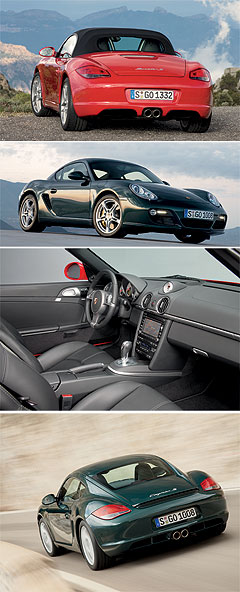Future models - Porsche - BoxsterLA show: Mid-life makeover for Boxster and CaymanUnder the skin: External changes are minimal, but the new Boxster features significant new engine and transmission options. Porsche’s more affordable convertible and coupe models gain 911-style improvements21 Nov 2008 BOXSTER and Cayman have followed their rear-engined 911 big brother into the blink-and-you’ll-miss-it makeover room, but gain new engines, Porsche’s acclaimed PDK dual-clutch gearbox and a host of minor improvements designed to keep the mid-engined pair fresh. But don’t expect to be driving one until late March next year at the earliest. The Germans have restyled the nose and tail, but the headlights, boasting what Porsche calls Carrera GT-style integrated indicators, are less obviously new than the peanut-shaped LED tail-lights that taper to the curvy flanks of both the Boxster and Cayman. Trainspotters will be able to pick the closed car from the soft-top convertible Boxster by its different front air intake, round (rather than rectangular) fog lights and rear wind deflector plate. On the subject of lights, both 987 series cars score optional bi-Xenon high discharge headlights with LED daytime driving lights. Step inside and the latest 911-style centre console revisions are recognisable, along with he rocker switches on the steering wheel spokes of PDK-equipped vehicles that denote a change of transmission and other major mechanical hardware upgrades.  Six months after being introduced in the 911, a completely new family of flat-six engines has found its way into the Boxster and Cayman. Six months after being introduced in the 911, a completely new family of flat-six engines has found its way into the Boxster and Cayman.But, while all 911s now feature direct-injection to optimise performance and efficiency, the smallest new engine-family member – a 2.9-litre flat six in the entry-level 987s – misses out on the new technology. Up from 2.7 litres in the previous base Boxster and Cayman models, it produces 188kW of power in the former and 195kW in the latter – 8kW and 15kW more than before and further differentiating the siblings. Meanwhile, the 997 Boxster S sees its third engine revision in the guise of the 11kW more powerful 228kW 3.4-litre direct-injection flat-six (which is upgraded to 235kW for the Cayman S). The latter, with Porsche’s new launch control mode switched on as part of the PDK’s optional Sports Chrono Package, now races from 0-100km/h in 4.9 seconds, putting it right into 911 3.6 territory. At the other end of the scale, the basic 2.9-litre Boxster – at last with a six-speed manual gearbox as standard, banishing the old five-speeder forever – takes a full second longer over the same distance, at 5.9 seconds. PDK (which stands for Doppelkupplungsgetriebe) is a seven-speed double-clutch transmission developed with ZF and, like the unrelated DSG from the Porsche-owned VW/Audi group, differs from a conventional transmission by being a fully manual gearbox that comprises two clutches that activate two separate sets of pre-selected gear ratios. Choosing PDK means that the smaller-engined 987s fall under 9.0L/100km for EU4 standard average fuel consumption, an 11 per cent improvement over the previous five-speed Tiptronic automatic gearbox models. This saving leaps to 16 per cent with the ‘S’ models fitted with PDK compared to the old Tiptronic versions, with an average of 9.2L/100km. Porsche has also reworked the suspension slightly to enhance driving dynamics and ride comfort, there are wider wheels, larger brakes on the S models, the PSM Porsche Stability Management system has been improved with new functionalities, and modifications have been made to reduce steering forces and aid agility. Read more:Porsche's next 911 takes shapeBoxster pricing
Motor industry news |
Click to sharePorsche modelsResearch Porsche Boxster pricing
Motor industry news |














Facebook Twitter Instagram